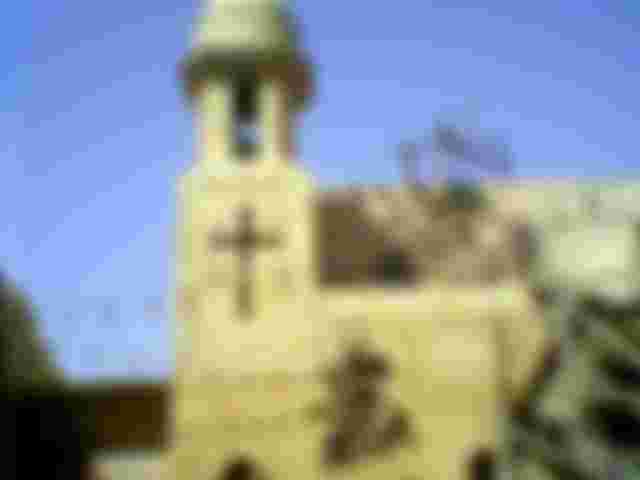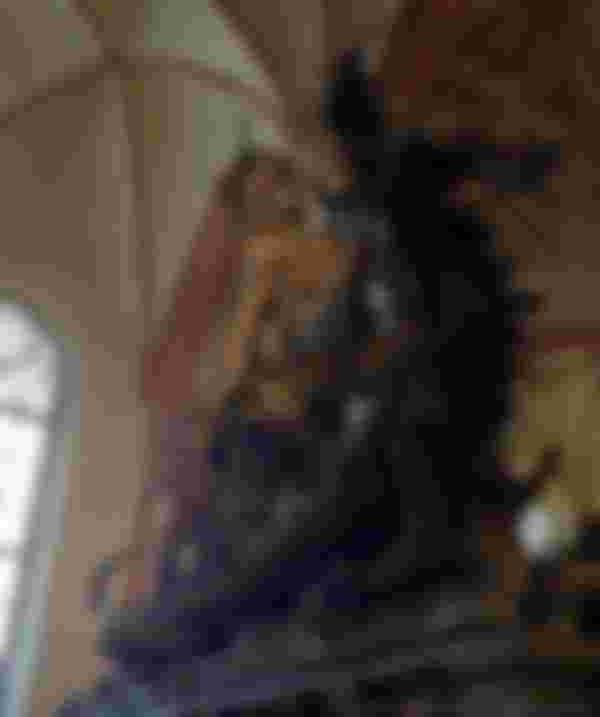There is an old tradition of a combat between a dragon and a dragon slayer. Often the point is to save a virgin otherwise selected as a sacrifice to the dragon. I don't know why dragons developed such an appetite for virgins, real or symbolic, or exactly what is behind the theme, but it became almost archetypal. The most famous representation of this story is the one about St. George.
St. George - Mar Girgis
St. George is the protector saint of England. But he is more related to Egypt, where his remains are. (In the monastery of Misr Al-Qadima in Old Cairo.) He is a highly respected figure there, even among non-Christians. The Egyptians call him Mar Girgis; in the Egyptian countryside he is sometimes called Sarie Al-Nadha. Depictions of his fight with the dragon are abundant; for instance, on this church in Old Cairo. Notice the two steel wire-like depictions of Mar Girgis and the dragon.

Mar Girgis was a Christian and was for that reason executed in Nicomedia by Emperor Diocletian on 1 May, 307 AD. He is said to have converted the Emperor's wife to Christianity. She was also executed.
Mar Girgis' life is a remarkable series of events. During seven years of torture he died three times, was resurrected two, and inspired a lot of people to assume the Christian faith. In addition to that, he is the world's probably most famous dragon slayer. The battle with the dragon took place in the town of Selene, in today's Libya, where Mar Girgis had saved the king's daughter, Sabra, from being sacrificed to the dragon. It is impossible to fully assure the origin of the legend, but there is quite a plausible theory that the dragon symbolises Roman Emperor Diocletian. It is a little contradictory; Mar Girgis killed the dragon while Emperor Diocletian killed Mar Girgis. But seen from a Christian perspective, Christianity eventually won the battle against the ancient Roman religion. It might be that Mar Girgis' fight against the dragon expresses just that.
But why a dragon?
Some historians, and I am inclined to agree with them, believe that the image of Mar Girgis and the dragon is based on an old Pharaonic image of a falcon-headed creature that kills a crocodile - a representation of Horus killing Set - a revenge for his murdered father, Osiris. It reflects one version of the myth, where Sobek, the crocodile god, allowed Set to adopt crocodile shape in order to escape the revenge of Horus.
History's Mar Girgis is considered to have been a Roman soldier born in Cappadocia (in present Turkey) about 280 AD. His father was a Roman officer and his mother was Syrian.
In fact, there are no certain facts at all about Mar Girgis. The legend has long ago put a compact shadow over reality, which can no longer be discerned in the mists of history.
The Coptic Church of Egypt celebrates Mar Girgis, the Prince of Martyrs, on several occasions during the church year.
Other places and cultures have adopted the myth about St. George and the Dragon and interpret its symbolism in various ways.
St. George & the Dragon (St. Göran & Draken) in Scandinavian History
In Sweden, St. Göran (local name of St. George) and the dragon came to have a specific symbolic meaning: Sten Sture's battle against the Danes. Sten Sture the Elder as St. Göran; the Danes as the Dragon; Stockholm, the capital of Sweden, as the rescued Princess. Sten Sture decisively defeated the Danish invaders at the Battle of Brunkeberg on 10 October 1471. To commemorate the victory, the famous statue in Storkyrkan, in Stockholm, was raised in 1489. (Image below)

Mar Girgis, or St. George, lived during Roman times. However, the theme with dragon and dragon slayer is probably older than that, although the virgin is missing.
I already mentioned one source of the image of Mar Girgis and the Dragon: the Pharaonic image of Horus killing Seth. But there is another story as well. The one about Apep and Ma'at. So let us return to old Egyptian mythology.
Apep & Ma'at
Apophis or Apep was a primordial being, a serpent (possibly a dragon), which existed in the very creation of the world. Apep was the enemy of Ma'at, who symbolises "order".
According to the ancient Egyptians, Ma'at was the universal order, upon which the whole world rested. If the order collapsed, the whole creation would disappear. It was Pharaoh's main task to maintain the order, through law and justice.
Apep was an Egyptian serpent, representing "chaos" in opposition to "order". Magical rituals were performed, which are described in several places - and, at various festivals, images of Apep in papyrus or wax were burned and abused. These symbolic destructions of Apep symbolised Ra's and Ma'at's victory over Apep - that is, how order defeated chaos.
The combat between Ma'at and Apep might very well be history's oldest combat between dragon and dragon slayer.
Copyright © 2020 Meleonymica/Mictorrani. All Rights Reserved.
The photos are mine and Copyright © Meleonymica, All rights Reserved.
All my articles about Egypt and Egyptology can be found here, and articles related to dragons, here.
Interested in history, legends and myths, join my community History, Myths, Legends & Mysteries (be45).
You find all my writings on Read.Cash, sorted by topic, here.


Amazing article indeed.